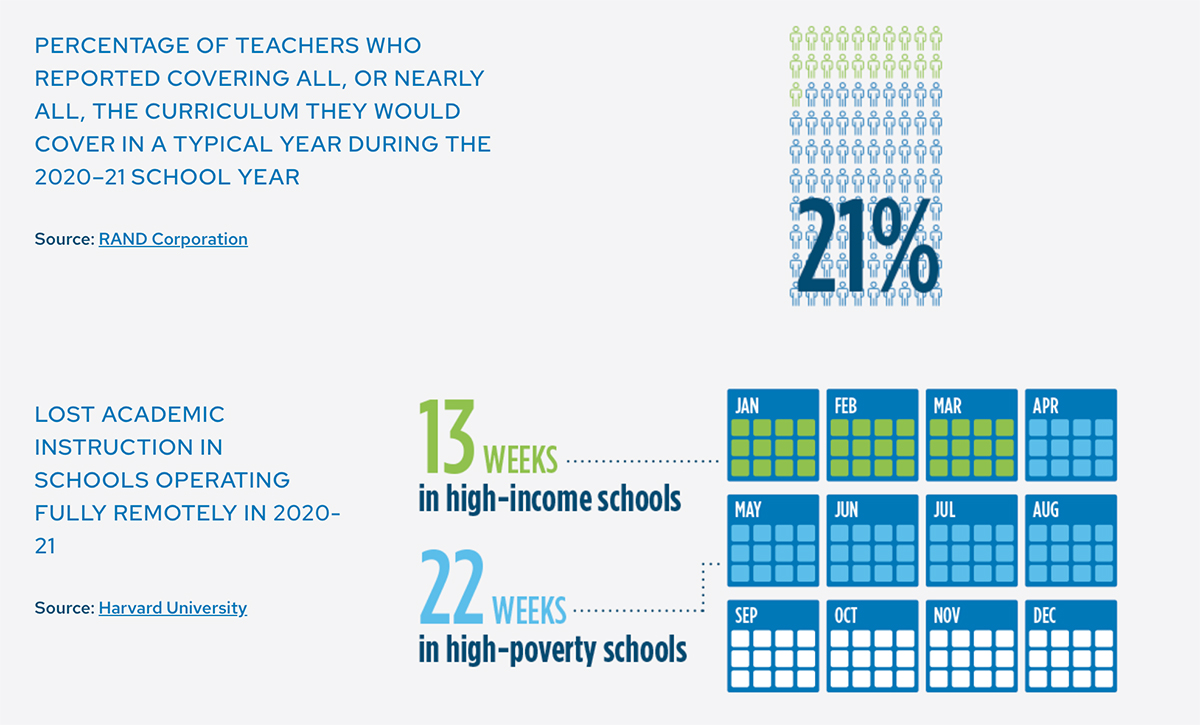EXCLUSIVE: CRPE Situation Report — State of the American Student, September 2022
Lake & Pillow: Barring urgent action and a radical course correction, the pandemic's harms will follow many more graduates for the rest of their lives

Get stories like these delivered straight to your inbox. Sign up for The 74 Newsletter
New results from the National Assessment of Educational Progress showed historic drops in student achievement for 9-year olds across the country and even more devastating drops for the most vulnerable. America’s already shameful achievement gaps have become chasms.
These results are cause for alarm. But they are not cause for surprise.
Since February 2020, we have focused our work at the Center on Reinventing Public Education on understanding the responses of America’s school systems to COVID-19 from as many angles as possible. At every stage, we saw systems that were slow to respond to change, decisions driven by politics rather than evidence and uneven access to learning that consistently caused the most harm to the students with the greatest needs.
Most students have not fully recovered from the impact of the pandemic and school closures. Quarantines and staffing chaos meant many continued losing ground even after schools reopened last school year.
Today, we’re synthesizing more than 2½ years’ worth of insights into our new annual publication, The State of the American Student. We’ll continue to report on what students and families need, how school systems are responding, what barriers they face and what promising leapfrog innovations show potential to propel a more just, responsive and joyful public education system.
Our goal is to place students’ needs — and the diversity of their needs — where they belong: at the center of deliberation in statehouses and district offices across the country.
We must face facts: Barring urgent action and a radical course correction, the harms of the pandemic and education systems’ responses will follow many more graduating classes for the rest of their lives.
NAEP data for older students will be released in October, but there is every reason to believe it will be very bad news. Research out of Ohio and North Carolina shows that 10th grade math scores, in particular, took a precipitous drop this last year. With graduation just around the corner, these students have little time to recover. Their futures now rely on fast and effective interventions by their families or their schools.
Young people are resilient, and dedicated educators want to help them. And yet, the next five years will be a very trying time for American public education. School systems are under incredible strain. Political divisions increasingly impair school leaders’ ability to lead. Exhaustion and burnout are rampant, and it’s becoming increasingly difficult to attract and keep quality educators, especially in critical areas like math, science and special education. And depression, anxiety and struggles with identity and self-confidence are rampant among young people.
There could not be a more urgent time for our education system to be at its best and most innovative — but it is far from that. Federal dollars provide a temporary backstop but no guarantee that school systems will meet students’ immediate needs or address public education’s longer-term structural challenges. Assuming the funds expire in two years, untold numbers of school systems will face financial crises and be forced to lay off teachers based on seniority, not quality.
If the country enters an economic downturn, students could face bleak employment and earning prospects. In a darker scenario, America could face growing instability, inequality and civic unrest.
There is a more optimistic scenario, however. The nation could begin, this school year, to leverage American ingenuity and collective action to create urgent solutions for those most in need. Parents, students, community leaders, social service providers and employers could rally to provide mentoring and mental health support for high schoolers.
Districts could use federal pandemic recovery funding to pay for community-run tutoring to help students address gaps in their learning and for programs that aid high school students in gaining a foothold in college or career training — areas where many recent graduates are struggling.
States or the federal government could create funds to ensure every member of the COVID generation graduates prepared to succeed in college or start a rewarding career.
School districts with innovative and proven approaches for the most pressing challenges, such as learning loss recovery, teacher staffing and student mental health, should be compensated to offer to train and support more districts to replicate those practices. The federal government and private foundations should organize a focused and coordinated national research program to quickly identify effective interventions, tools, and school and staffing models.
States must be transparent about collecting and reporting on progress toward recovery, restitution and reimagining — and they should shift their school “report cards” to this purpose. Every family should have access to clear, accessible data on where their child stands. If their schools cannot deliver a full recovery for their child, they should have the ability to opt out and pay for other learning options.
The situation this September is one of joy and dread for thousands of students returning to classrooms at risk of graduating unprepared. Will we sit idly by, or will we choose a path forward that will take student needs seriously today and prepare for a better public education system tomorrow? The latter will require radically different approaches and a clear-eyed understanding of the difficulty of overcoming what one urban superintendent called our “addiction to the status quo” in a system built to resist, not embrace, change.
What we do next matters.
School district leaders, state policymakers and advocates can take important steps now to address students’ immediate needs and set the bar high for system transformation.
- Districts and states should immediately use their federal dollars to ensure every student in the COVID generation makes a full recovery. They must focus their resources on proven interventions, such as well-designed tutoring, extended learning time, credit recovery, additional mental-health support, college and career guidance, and mentoring. These needs are too daunting for schools to shoulder alone. Partnerships and funding for families and community-driven solutions will be critical.
- By the end of 2022-23, states and districts must commit to an honest accounting of rebuilding efforts by defining, adopting and reporting on their progress toward ambitious five- and 10-year goals for student recovery and reimagining. States should invest in rigorous studies that document, analyze and improve their approaches.
- Education leaders and researchers must adopt a national research and development agenda for school reinvention over the next five years. This effort must be anchored in the reality that students’ needs are so varied, so profound and so multifaceted that a single system can’t possibly meet them all.
- Recovery and rebuilding should ensure the system is more resilient and prepared for future crises. School systems must be equipped to deliver high-quality, individualized learning pathways for students. And educators must have flexibility to build on practices that show promise.
CRPE is committed to bringing forth student stories, transformative ideas and rigorous data to ensure the COVID generation is not forgotten. Every September for the coming 10 years should remind us of the urgency. Every return to school in the fall should be a call to action.
Get stories like these delivered straight to your inbox. Sign up for The 74 Newsletter

;)


